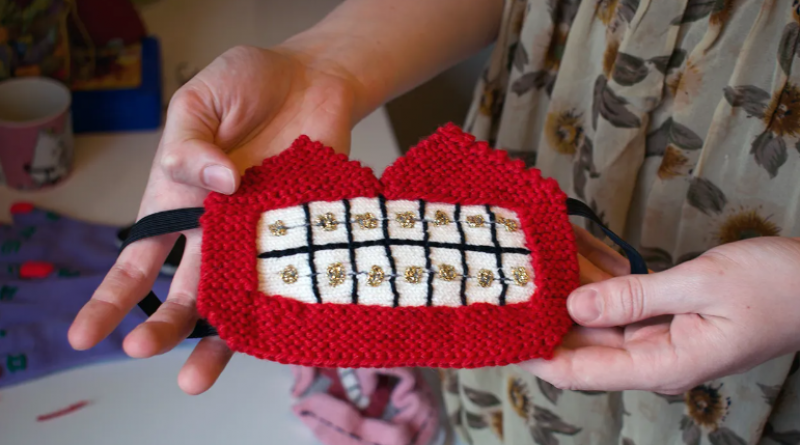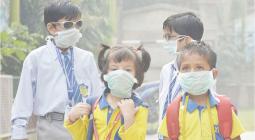Face Masks as a Fashion Accessory? Why We Should Encourage This Trend.

It started with Eve donning a black mask against a backdrop of wisteria flowers, hashtagging her efforts #MaskingForAFriend. Sophia Bush, Matt McGorry, and Mayim Bialik soon followed, with others quickly joining the cause launched by the Pandemic Action Network.
The goal? To spread accurate information about the benefits of masking, particularly for those around us. Because masking isn't about protecting ourselves; it's about protecting our loved ones and the loved ones of others.
Of course, the campaign has had the added bonus of celebrities normalizing the act of wearing a face mask and proving that doing so can even be trendy.
But could it become something more here in the United States?
In many Asian countries, wearing a face mask in public has been a cultural norm long before COVID-19.
Industrial and organizational psychologist Lana Ivanitskaya, a professor at Central Michigan University, says the embracing of face masks in those areas came about for several reasons.
"First, there was rapid industrialization that led to bad air quality," she explained. "Then, of course, there were recent diseases that disproportionately impacted those areas of the world. I'm thinking of SARS specifically."
Ivanitskaya, who has been working hard to normalize mask wearing, and who has enlisted the help of Amish and Mennonite communities in making masks to distribute across the country, says these experiences shifted the cultural mindset toward respiratory protection.
She added, "I'm confident that cultural factors, such as collectivism and understanding of other people's needs, has also played a role."
How Do Masks Protect People From COVID-19?
There's been a lot of confusion surrounding the benefits of using masks in the battle against COVID-19, and even the U.S. government has sent conflicting messages.
But now, thanks to evolving science and a better understanding of exactly whom masks protect, most health officials seem to finally be on the same page.
"CDC recommends that people wear a cloth face covering to cover their nose and mouth in the community setting," said Dr. Mike Bell, deputy director of the Centers for Disease Control and Prevention (CDC) Division of Healthcare Quality Promotion. "This is to protect people around you if you are infected but do not have symptoms by blocking your respiratory droplets."
Bell has been working to provide the necessary medical perspective for the #MaskingForAFriend campaign, explaining that masking for others is what scientists and medical experts refer to as source control.
"If everyone does this, the amount of infection being spread in our communities can be greatly reduced," he said.
What Else Might Masks Protect Against?
Dr. Kierstin Kennedy, chief of hospital medicine at the University of Alabama at Birmingham, said, "Masks can protect against any infectious illness that may be spread by droplets. For example, the flu, pertussis (whooping cough), or pneumonia."
Bell agrees, adding that wearing a cloth mask has benefits beyond slowing the spread of COVID-19, and that source control can reduce the transmission of many other easily spread respiratory infections — the kind that typically render people infectious even before they display symptoms, like influenza.
"Some international reports have noted a lower impact of flu related to the uptake of measures to prevent COVID-19," Bell said.
But that doesn't necessarily mean masks are for everyone.
"Cloth face coverings should not be placed on young children younger than 2 years of age, anyone who has trouble breathing, or anyone who is unconscious, incapacitated, or otherwise unable to remove the cover without assistance," Bell explained.
Could Face Masks Become an Ongoing Trend?
The experts we spoke with agree that until the threat of this pandemic has been neutralized, people should embrace the protection masks allow them to provide to those around them.
After all, it's not necessarily about you — it's about everyone you come in contact with.
It's not at all uncommon to be an asymptomatic carrier of the new coronavirus — which means that even if you have no symptoms at all, you could potentially transmit the virus to someone who could then become gravely ill or even die.
A mask, alongside frequent handwashing and physical distancing measures, like staying at least 6 feet (2 meters) apart, reduces that risk.
But could this be a trend that continues even after COVID-19? And perhaps the more important question: Should it?
"As we start to navigate life beyond the stay-at-home orders, we likely will need to continue to use face masks if we want to prevent continued transmission," Kennedy said.
But she's unsure of what the future may hold beyond that.
"Once the threat of COVID-19 is gone, I don't think that ongoing use of face masks in public has to continue, though it remains to be seen whether we will adopt ongoing face mask use just as we have seen in Asian countries," Kennedy said.
Being Honest About the Drawbacks of Face Masks
While wearing a face mask in public is one more way we can help protect our friends, loved ones, and community, that doesn't mean doing so is without sacrifice.
"Face masks certainly impact the way that we interact socially," Kennedy said. "You lose the ability to connect with others in the nonverbal ways that are customary."
As an example, she says before COVID-19 you may have flashed a warm smile to someone you were rushing past in the street — a way to convey you weren't trying to be rude and to pass along a nonverbal hello.
"We will likely have to find a new normal as it relates to expected social interactions," she said.
Face masks also affect individuals with hearing disabilities, who often rely on lip reading to some extent to effectively communicate with others.
However, for those who are simply struggling with embarrassment over wearing a mask when others are not, she pointed out, "There is nothing awkward or embarrassing about protecting your health or the health of those around you. Find a mask that fits and wear it proudly."
Bell agrees. "The good thing about everyone wearing a cloth face cover when they're out in public is that it sends the message that we're all in this together, and there's no reason to be embarrassed about wearing one," she said.
In other words, the more people who take that step, the more united we will be.
But there's one more complaint about face masks that may present a bigger challenge: For some people, breathing behind the mask has proven to be difficult. And for those with anxiety or other respiratory conditions, restricted breathing can become a quality of life issue.
If you're having a hard time breathing behind your mask, Kennedy said, "The size or style of the mask may be the issue."
She encourages people to try different types of face coverings to find what works for them.
"The ideal mask is snug enough to fit close to the face (no gaps) to prevent droplets from entering or exiting around the sides, but large enough that it is not restrictive or negatively impacting your ability to breathe," Kennedy said.
As part of Ivanitskaya's work, she's actually been experimenting with different materials and varying numbers of layers required to help people be comfortable in their masks while providing the most amount or protection possible.
Her team has even produced science-based resources regarding best practices for sewing washable face masks, for those interested in achieving the balance between comfort and protection.
"It's a very real issue," Ivanitskaya said. "I'm with a group of researchers who have been developing mask construction advice, and we are suggesting materials and mask designs. One of the masks we made that seemed very reasonable, I pretested on myself, wearing the mask uphill as I rode my bike."
But the same mask Ivanitskaya was able to wear without issue turned out to be impossible for her 88-year-old neighbor to keep on.
In fact, he told her he was choking inside of it. After another older neighbor reported the same experience, Ivanitskaya turned to the research and discovered evidence of diminished lung capacity among older adults.
That was when she started experimenting with finding the sweet spot between protection and tolerability for those who may not be able to breathe as easily from behind a mask.
What she discovered is that different people have different levels of tolerability when it comes to mask wear — and factors like outside temperatures, whether the wearer also uses glasses, and even nose size can all play a role.
Finding a mask you can comfortably keep on should be the ultimate goal, even if it doesn't provide exactly the same level of protection as someone who may be able to tolerate more layers and a tighter seal.
Functional — and Fashionable
But it's not just improving comfort that face mask designers are now focusing on. Many are also trying to create masks people actually want to wear — masks others might find as an aesthetically pleasing and fun way to accessorize.
If you think that sounds crazy, just remember: Sunglasses and hats once started out as items meant to simply protect the wearer from the sun.
They've now evolved into fashion accessories providing countless options to choose from.
"Many businesses, small and large, have taken the opportunity to make and sell cloth face covers. A wide variety of styles and designs are already available," Bell said. "We're already seeing a lot of people not only wearing cloth face coverings, but making a design or fashion statement with their choice of cover."
Whether it's the design you choose or the way you fasten your mask to your face (with a popular debate now ensuing over whether ear loops or clasps behind the head are better), you have an opportunity to make a statement with the mask you wear — and protect others in style.
Reposted with permission from Healthline. For detailed source information, please view the original article on Healthline.
17 May 2020
EcoWatch




